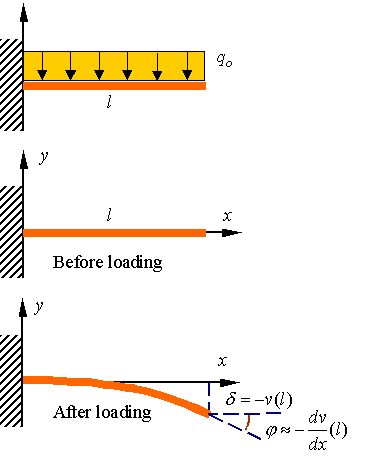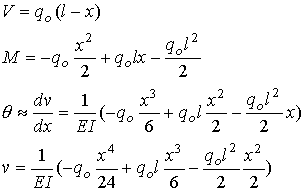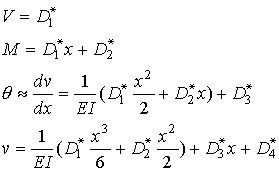Beam Deflection
Curvature of a line:

The
radius of curvature ![]() , which is the radius of the circle that best “fits” a line
at a given point, is the reciprocal of the curvature
, which is the radius of the circle that best “fits” a line
at a given point, is the reciprocal of the curvature ![]() of the line. From
calculus we know that the curvature
of the line. From
calculus we know that the curvature ![]() of a line described
by the function y = f(x) is given by the relation
of a line described
by the function y = f(x) is given by the relation

The beam
deflection equation:

A
beam under load deflects and bends. As shown in the figure, if the deflection
of the beam is given by the displacement function v in terms of location
x, from calculus we conclude that the curvature ![]() of the beam is given
of the beam is given

If
the slope ![]() of the curve
describing the loaded beam is at all points small relative to unity then
of the curve
describing the loaded beam is at all points small relative to unity then ![]() and one can set the
denominator of the expression for curvature equal to one. As a result, one
obtains the approximate relation
and one can set the
denominator of the expression for curvature equal to one. As a result, one
obtains the approximate relation

From
the study of pure bending we know the relation between the radius of curvature
and the applied bending moment to be given by the expression

Combining
the relation for curvature from calculus and that obtained from mechanics of
materials yields the beam equation:

As the derivation implies, the beam equation in this form
only hold for beams that at all points have small slope angles. This
restriction can be removed by avoiding the approximation and using the full
expression for curvature, but this not necessary for many applications that
result in only small changes in the shape of the beam.
Uniform beams:
For
beams with constant EI, one can easily differentiate the beam equation
twice to get

This
follows from the relations ![]() and
and  that was obtained
when we studied the shear and bending moment in beams. This expression can be
integrated four times to get displacement v as a function of position x.
The resulting expression will contain four constants of integration that are
evaluated from imposing four boundary conditions. In general the process
follows the following sequence:
that was obtained
when we studied the shear and bending moment in beams. This expression can be
integrated four times to get displacement v as a function of position x.
The resulting expression will contain four constants of integration that are
evaluated from imposing four boundary conditions. In general the process
follows the following sequence:

The
four constants of integration are D1, D2, D3,
and D4.
Example 1:
As
an example, let us evaluate the deflection of a cantilevered beam of length l
loaded by the application of a uniform load qo.

The
equations are

The
boundary conditions on this beam are as follows. The slope and displacement at
the left end must be zero since the support does not allow this end to move or
rotate. The shear force and bending moment must be zero at the right end since
it is free.

These
boundary conditions require that

Therefore,
the equations for the beam become

The
slope and deflection at the right end is given by

The
support reactions at the left end can directly be calculated from the equations
for the shear and bending moments by substituting zero for the value of x.
This results in


Example 2: A beam with two segments
In
the following simply supported beam we look at a beam that has two segments
(from A to B and from B to C), on each the segments the functions are
continuous but the shear load has a jump due to the point load P when you go
from one segment to the other. As a result one has different constants of
integration for each segment.

Since the distributed load is equal to zero in both
segments of the beam, the equations will be the similar up to the values of the
integration constants. The equations for the first segment are as follows.
From A to B (0<x<a):

The equations are similar in the second segment, up to the
integration constants. These equations are as follows.
From B to C (a<x<a+b):

The
boundary conditions at the two ends are as shown in the figure. As can be seen,
the supports at the two ends impose a zero displacement condition and since the
ends are free to rotate, the moment at each end is also zero. In addition to
these four boundary conditions there are four continuity conditions at point B.

In
addition to these four boundary conditions there are four continuity conditions at point B. Due
to the point load, the shear load will have a jump at this point, but the other
three variable do not change. All together, we will have eight conditions that
will be used to solve for the eight constants of integration. These conditions
are as follows, where l = a+b.

Once
the eight constants Di and Di*
are determined from these eight conditions, back substitution into the above
equations gives the equations for the deflection of the beam in each of the two
regions.
Example 3: Statically indeterminate beams
Consider
the cantilever beam of the first example now propped up using a support at the
right end. An examination of the free-body-diagram of the beam immediately
indicates that the beam is statically indeterminate since we have four unknown
support reactions and can only write three equilibrium equations.

Since
the distributed load on the beam is the same as in the first example, the
equations for this beam will be similar to the first problem, but with
different constants of integration. The equations are therefore given by the
following set.

The
boundary conditions for the left end are the same as the first example, but the
boundary conditions on the right end require zero displacement and zero moment.

These
four constraints are written as follows.

Solving
these equations for the unknown constants of integration gives the following
relations.

Substitution
back into the original equations gives the following four equations for the
beam.

The
support reactions can be calculated from the following relations.

![]()
ã Mehrdad Negahban and the University of Nebraska, 1996-2000.
All rights reserved
Copy and distribute freely for personal use only
Department of Engineering Mechanics, University of Nebraska, Lincoln, NE 68588-0526
Last modified at: 5:41
PM,
Thursday, April 13, 2000